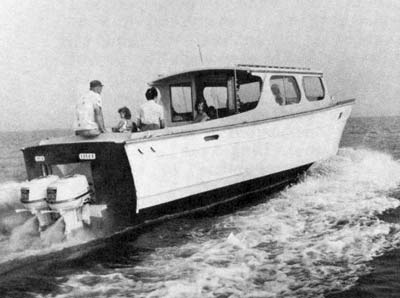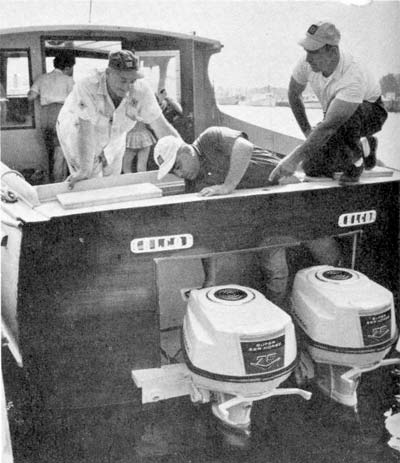It all began near the end of the 1959 boating season when Henry
Verrier of Coventry, Rhode Island, looked at his 40-foot Eico
cabin cruiser with considerable dismay.
The boat was 11 years old and it's two 135 horsepower inboard
engines were "good in their day, but their day was
over, " as Verrier put it. Replacing the big inboards would
be too expensive, almost equal to the price of a new boat.
About that time, Verrier's friend, Tom Salzillo, was showing
the Johnson movie, "Three For Adventure,'' to some relatives
and friends. The film depicts the crossing of the Atlantic Ocean
by three men in a 22-foot outboard cruiser with a pair of Johnson
50 h.p. motors.
Power Equals Inboards
After the movie, Verrier*s father-in-law, Leo Petreault, commented
that outboard power equaled that of many inboard boats and ought
to do just as good a job.
Salzillo, a Johnson Motors dealer in nearby Smithfield, R.I.,
knew the power of the V-75 h.p. engine and often thought there
were many uses for this power plant beyond single installations
on ski boats and cruisers. Why not apply twin V- 75 outboards
with its 150 horses to move Verrier's 11,040-pound, 40-foot
displacement-type hull?
On paper the plan looked good. Verrier and Salzillo talked
to many knowledgeable people with the consensus usually being
"in theory it should work, but in all practicality it never
will."
But Verrier and Salzillo were stubborn and decided to go ahead.
They had little to lose and much more to gain if they succeeded.
They weren't engineers, but they weren't novices either, since
both were in the marine business. Verrier owns the J & H
Boat Builders of Coventry and Salzillo the Acme Marine &
Supply Co. in Smithfield.

Twin Johnson V-75's power the 11,040 pound
converted inboard boat with ease at speeds in excess of 20 m.p.h.
Began With Sketches
The Rhode Islanders began their project with sketches. Since
neither of them were draftsmen, they spent many long winter
nights laboring over the conversion plans,
The first major problem concerned the transom. The old Eico
had a rounded transom. This meant building a square
section, cutting through and constructing a water-tight well.
The outboards had to be installed with the motor mounts on square
facing and proper drains had to be accompplished to eliminate
the backwash.
Next came the controls. Conventional outboard controls were
not made in long enough lengths. Inboard controls would not
operate on outboards. To solve the problem they devised a unique
linkage between the two types, which consumed most of their
early summer evenings.
Steering presented another challenge. Eventually the steering
was built with rods and linkage. The throttle and shift used
the same system going back to a section just forward to the
transom, where the rods were joined to the con- ventional outboard
controls.
Many Long Hours
Making these adjustments and conversions may seem simple on
paper, but they represented many hours of hard
work and spare time.
Finally in the first week of August, 1960, the day of launching
came. The pair had planned to slip the big boat into the water
quietly, but word leaked out and a fairly large crowd gathered.
It consisted of the serious doubters who had come to jeer, the
half-hearted doubters who had come to cheer, and the just normally
curious.
As the twin Johnson 75's responded to the electric starting
mechanism, the scepticism began to disappear. Within minutes
it was all gone. When Verrier put his hand on the forward throttle,
the big five and a half ton boat began to inch forward slowly.
Gradually it picked up speed, then shoving the throttle fully
forward the 40-foot cruiser responded with amazing alacrity.
Within minutes it was headed out to Narragansett Bay.
Verrier and Salzillo put the boat through many tests that
day. The first thing that surprised them was the speed of the
converted craft. The boat moved at a top speed of 20 miles per
hour as compared with their top inboard power-
ed speed of 18 m.p.h.
Use Less Fuel
But speed wasn't the only surprise. They had reasoned the
outboard engines would be more costly to operate, but were amazed
to discover the two Johnson 75s were burning only 14 gallons
of fuel an hour. In the past, with two 135 h.p. inboard engines,
the boat was using an average of 23 gallons at top speed.

Johnson dealer Tom Salzillo
(center) makes a last minute check m the motor well of the converted
40-foot inboard boat, while Henry Verrier (right) explains to
a friend how the stern of the craft was converted for use with
two John son V-75s
The first day tests were conducted with 10x11 pitch propellers,
which are standard on most Johnson 75 h.p. engines, but much
too large for such a heavy boat. The motors turned over only
3400 revolutions per minute (r.p.m.) with these props, instead
of the required 4500
r.p.m's.
A few days later, Verrier put on 9-inch props to bring the
r.p.m. to 4000 and powered the boat to 21.5 miles per hour.
Verrier has ordered special 8-inch props and figures these propellers
should turn the engines the full 4500 r.p.m/s and produce a
top speed of 23 m.p.h.
One test which had little scientific value, but certainly
added to the pleasure of boating, was putting the boat onto
a beach. This is rarely possible with inboards because of the
deep draft of the props and rudder. With outboards, however,
the only limiting factor is the draft of the hull itself.
Easy To Beach
The displacement hull of Verrier's boat is shallow enough
to allow it to come within easy wading distance of any beach.
The boat can rest in less than a foot of water at the bow, and
21/2 feet at the stern.
The final plus in the conversion to outboards was the increased
space in the boat's cockpit.
Verrier, besides sampling the sweet taste of victory over
doubtful friends' now has a boat that will allow him to cruise
more economically in the future as well as eliminating for all
time the necessity of facing expensive engine replacements before
the end of the life of the boat itself.

